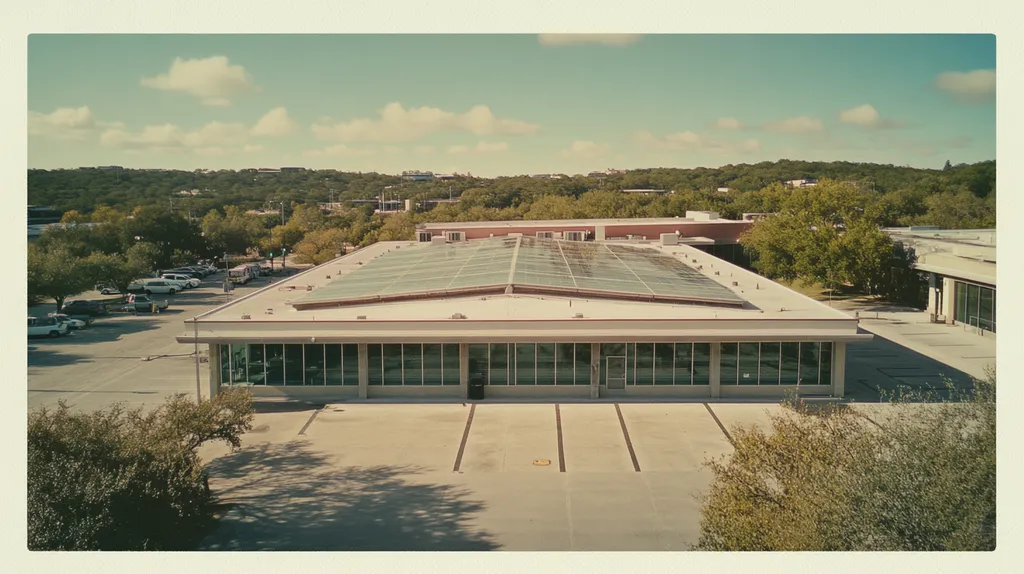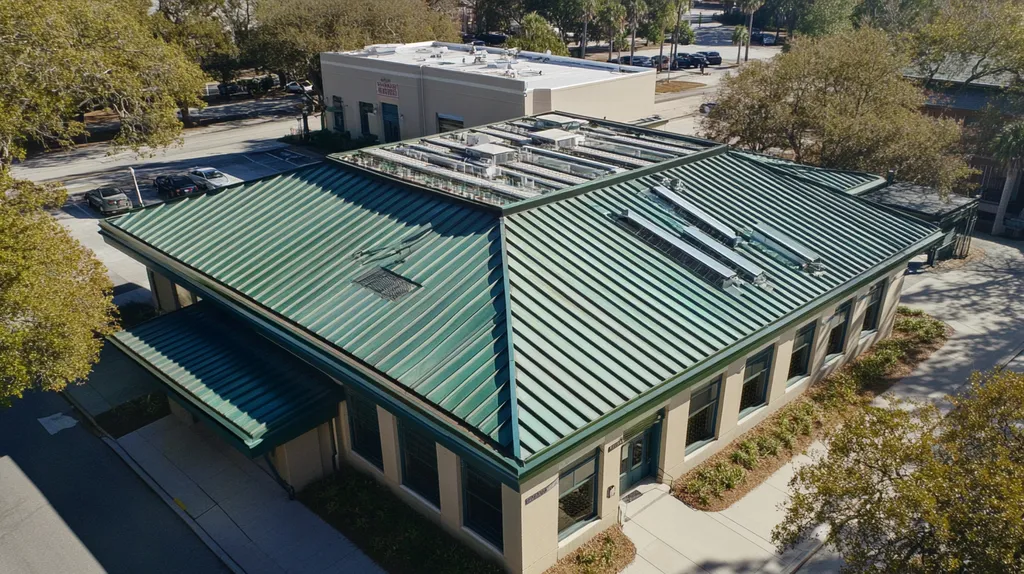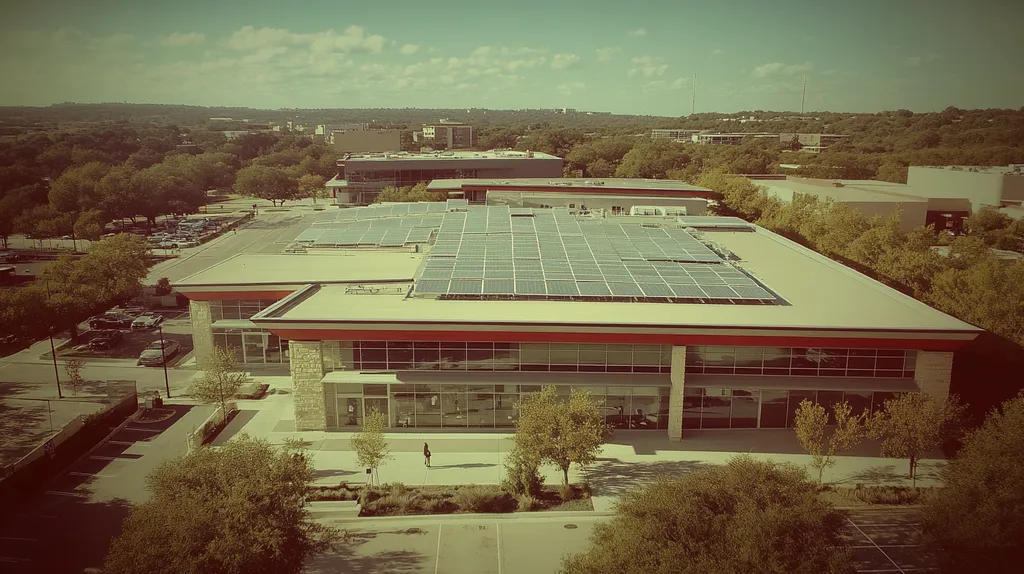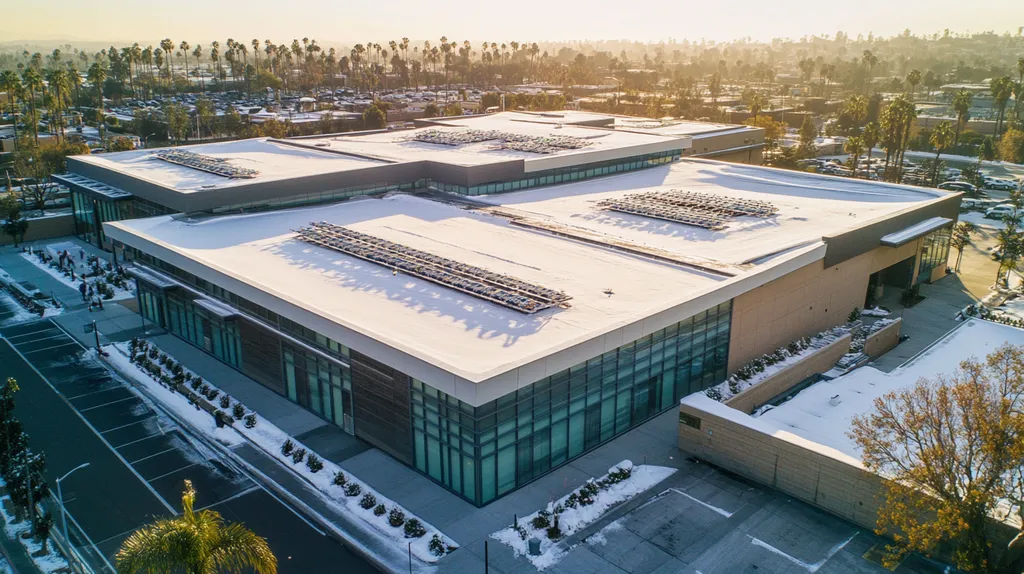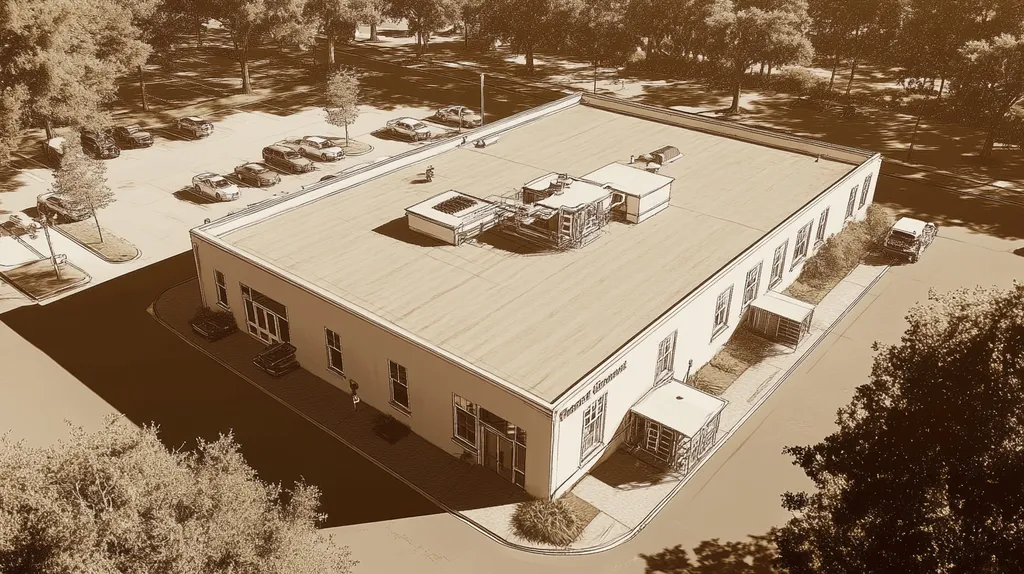Commercial roofing warranties represent a $4.2 billion industry marked by widespread misunderstandings that cost property owners millions in denied claims annually. Recent studies show that over 70% of commercial building owners misinterpret their warranty coverage, leading to costly repair delays and premature roof failure.
From material versus workmanship protection to maintenance requirements, these critical gaps in warranty knowledge create significant financial exposure for facilities across all sectors.
This comprehensive analysis examines six key areas where warranty misconceptions impact building operations, while providing evidence-based strategies for maximizing roof system protection and longevity.
SECTION 1: COMMON MISCONCEPTIONS
Commercial roofing warranties represent one of the most misunderstood aspects of building protection, leading to significant financial exposure for property owners. Recent industry data shows that over 70% of warranty claims are initially denied due to misunderstandings about coverage scope and maintenance requirements. These misconceptions create a false sense of security while leaving buildings vulnerable to costly repairs.
Misunderstanding Coverage: Material vs. Workmanship Warranties
Many commercial roofing systems carry warranties that extend far beyond their expected service life, creating a dangerous illusion of protection. These warranties typically exclude the most common types of failures that occur as systems age, particularly at critical points like seams.
Material warranties focus solely on manufacturing defects, covering specific components rather than the entire roofing system. Even a 20-year material warranty offers no protection against installation errors or performance issues unrelated to product quality.
Workmanship warranties address installation quality but usually expire within 2-5 years. This limited duration leaves a significant gap between material and labor coverage, potentially exposing owners to substantial repair costs.
The reality is that many warranty documents contain complex exclusions that effectively eliminate coverage for the most likely failure points. (source: Castagra Products, Inc.)
Belief That Warranties Eliminate the Need for Maintenance
The presence of a warranty often creates a false sense of security, leading property owners to neglect essential maintenance. This misconception can result in accelerated deterioration and invalidated warranty coverage.
Most warranties require documented proof of regular maintenance performed by qualified professionals. Failing to maintain these records can void coverage, even for legitimate manufacturing defects.
Preventive maintenance identifies potential issues before they escalate into major problems. Early intervention often costs a fraction of emergency repairs and helps maintain warranty validity.
Regular inspections also document pre-existing conditions, strengthening the property owner’s position when filing warranty claims.
Assuming Warranties Cover All Types of Roof Damage
Property owners frequently overestimate the scope of warranty protection, assuming coverage extends to all types of damage. This misunderstanding leads to delayed repairs and increased repair costs.
Standard warranties typically exclude damage from severe weather events, unauthorized repairs, and changes to building use. These exclusions often catch owners off-guard during critical failures.
Warranty coverage can become void if repairs utilize unauthorized materials or are performed by non-approved contractors. This restriction limits owner flexibility in addressing emergency situations.
Understanding these limitations enables property owners to develop comprehensive risk management strategies that extend beyond warranty protection.
SECTION 2: PRACTICAL IMPLICATIONS
Commercial roof warranties carry significant financial implications that directly impact building operations and asset value. Industry data reveals that mismanaged roofing systems can reduce a building’s operational lifespan by up to 30% while increasing energy costs by 20%. Understanding these practical implications helps property owners make informed decisions about maintenance, repairs, and warranty compliance to protect their investment and avoid unexpected expenses.
Consequences of Ignoring Routine Roof Maintenance
Regular roof maintenance represents a critical investment in building protection. Deferred maintenance often leads to accelerated deterioration, compromising structural integrity and creating safety hazards for occupants.
When maintenance lapses occur, minor issues can quickly escalate into major problems. Water infiltration, for instance, can damage insulation, corrode structural components, and create conditions for mold growth – all of which may fall outside warranty coverage.
The financial impact extends beyond immediate repair costs. Neglected roofs often require premature replacement, disrupting business operations and creating unexpected capital expenditures.
Warranties are limited and often misunderstood, typically covering only defects in materials while excluding damage from lack of maintenance, improper repairs, or environmental factors. (source: A. Kimerer & Associates)
Impact of Warranty Limitations on Repair Decisions
Warranty limitations significantly influence repair timing and methodology. Property owners must carefully evaluate whether proposed repairs align with warranty requirements to maintain coverage validity.
Unauthorized repairs, even when well-intentioned, can void warranty protection. This creates situations where emergency fixes lead to long-term financial exposure through invalidated coverage.
Many warranties require specific repair protocols and approved materials. Deviation from these requirements, even if more cost-effective in the short term, can compromise long-term protection.
Understanding these limitations helps owners develop comprehensive repair strategies that preserve warranty coverage while addressing immediate building needs.
Importance of Clear Warranty Terms for Building Owners
Clear warranty terms establish essential frameworks for maintenance planning and risk management. Property owners need explicit documentation of coverage scope, maintenance requirements, and claim procedures.
Ambiguous warranty language often leads to disputed claims and delayed repairs. Building owners should insist on detailed explanations of all warranty provisions during contract negotiations.
Documentation requirements play a crucial role in warranty enforcement. Maintaining detailed maintenance and repair records strengthens the owner’s position when pursuing warranty claims.
Regular warranty review ensures alignment between maintenance practices and coverage requirements. This proactive approach helps identify potential gaps in protection before they result in costly repairs.
SECTION 3: COST OF MISINFORMATION
Misunderstandings about commercial roof warranties create devastating financial consequences for property owners, with typical repair costs increasing 3-5 times when warranty coverage is incorrectly assumed. Recent analysis shows that over $2.1 billion in avoidable roofing expenses occur annually due to warranty misinterpretation and subsequent maintenance delays. This pattern of costly mistakes stems from three key areas: misinterpreted coverage terms, delayed repairs due to coverage confusion, and neglected inspection requirements.
Financial Risks of Relying on Misinterpreted Warranties
When property owners misinterpret warranty coverage, they often postpone critical maintenance based on false assumptions about protection. These decisions typically result in repair costs 300-500% higher than necessary, as minor issues escalate into major structural problems.
Coverage misunderstandings frequently lead to improper repair methods that void remaining warranty protection. Once warranty coverage is compromised, owners face full financial exposure for all subsequent repairs, even those that would have been covered originally.
Most devastating are situations where owners discover their warranty requires specific maintenance protocols only after significant damage has occurred. This realization often comes too late to prevent both the immediate repair costs and the loss of long-term protection.
Expenses from Uncovered Damages and Repair Delays
The financial impact of warranty-related repair delays compounds rapidly, with typical water damage costs increasing by $2-3 per square foot for each month of delay. These expenses accelerate when moisture penetrates beyond the roofing membrane into insulation and structural components.
Secondary damage from delayed repairs often exceeds the cost of the original roofing issue. Moisture infiltration can compromise electrical systems, damage inventory, and create workplace health hazards – none of which fall under standard warranty coverage.
Emergency repairs necessitated by delayed maintenance typically cost 4-6 times more than scheduled maintenance. This premium reflects both the urgency of the work and the limited contractor options available for immediate response.
The cascade of damage from delayed repairs often triggers business interruption costs that dwarf the direct repair expenses. These operational impacts include temporary relocations, production delays, and potential loss of tenants.
Long-Term Costs of Neglected Roof Inspections
Skipping required inspections typically reduces roof system lifespan by 30-40%, forcing premature replacement years before the warranty period expires. This acceleration of the replacement cycle creates significant unexpected capital expenses.
Missing preventive maintenance opportunities leads to energy efficiency losses of 15-25% as roofing systems deteriorate. These increased utility costs compound monthly, creating substantial operational expense increases over time.
The most significant long-term impact comes from compromised building value, as poor roof condition can reduce property valuation by 10-15%. This devaluation affects everything from insurance rates to refinancing options.
Regular inspection programs typically cost less than 1% of roof replacement value annually while preventing up to 90% of premature failures. This investment provides both immediate protection and long-term cost avoidance through extended roof life.
SECTION 4: REALITY CHECK
Commercial roofing warranties represent a critical yet frequently misunderstood aspect of building protection, with over $500 million in denied claims annually due to warranty misinterpretation. The complexity of modern roofing systems, combined with increasingly detailed warranty requirements, creates significant financial exposure for property owners who fail to understand their coverage. Understanding the reality behind warranty protection helps owners avoid costly oversights and maintain effective building protection.
Differentiating Between Manufacturer and Workmanship Warranties
Manufacturer warranties focus specifically on material performance under normal conditions, typically offering 15-30 year terms for commercial roofing systems. These warranties cover defects in the roofing materials themselves but exclude many common failure points that develop over time.
Workmanship warranties, provided by installation contractors, protect against errors in application and installation. These warranties typically extend only 2-5 years from installation completion, creating a significant coverage gap between material and labor protection.
Many commercial roofing systems carry warranties that extend far beyond their expected service life, creating dangerous misconceptions about long-term protection. These warranties often exclude the most common types of failures that occur as systems age, particularly at critical points like seams. (source: Castagra Products, Inc.)
Understanding these distinct warranty types enables property owners to develop comprehensive protection strategies that address both material and installation risks. This knowledge proves essential when evaluating roofing proposals and planning long-term maintenance programs.
Common Exclusions in Commercial Roofing Warranties
Standard warranty exclusions often catch property owners by surprise, particularly regarding weather-related damage and unauthorized modifications. Most warranties exclude damage from severe weather events, even when the roofing system appears properly installed.
Maintenance-related exclusions represent another significant gap in coverage. Failing to perform and document regular inspections can void warranty protection, even for legitimate manufacturing defects.
Many warranties contain specific requirements regarding repair materials and authorized contractors. Using unauthorized materials or contractors, even in emergency situations, can invalidate remaining warranty coverage.
Understanding these exclusions helps property owners implement appropriate risk management strategies and maintain valid warranty coverage throughout the roof’s service life.
Necessity of Professional Installation and Documentation
Professional installation directly impacts warranty validity and long-term roof performance. Improper installation techniques can void manufacturer warranties before the building owner takes possession.
Documentation requirements play a crucial role in warranty enforcement. Without proper installation records, maintenance logs, and repair documentation, even valid warranty claims may face denial.
Certified contractors understand current installation standards and warranty requirements, ensuring compliance during initial installation and subsequent repairs. This expertise proves invaluable when warranty claims arise.
Maintaining detailed records of all roofing work strengthens the property owner’s position during warranty claims and helps identify potential issues before they escalate into major problems.
SECTION 5: EVIDENCE-BASED ALTERNATIVES
Commercial roof failures cost property owners over $3.5 billion annually in unplanned repairs and business disruption. While traditional warranties promise protection, data shows that proactive maintenance programs reduce lifetime costs by 50% compared to reactive approaches. Property owners who implement evidence-based alternatives to warranty-dependent strategies consistently achieve better outcomes through systematic maintenance, strategic contractor partnerships, and thorough pre-project verification.
Implementing Preventive Roof Maintenance Programs
Structured maintenance programs extend roof lifespans by identifying and addressing minor issues before they escalate into major failures. These programs typically cost 1-2% of roof replacement value annually while preventing up to 90% of premature failures.
Core maintenance activities must include quarterly inspections, drainage system cleaning, and immediate repair of minor defects. This systematic approach prevents the cascading damage that often occurs when small problems go unaddressed.
Digital documentation systems streamline maintenance tracking while creating defensible warranty claim records. Modern platforms integrate inspection reports, repair documentation, and warranty requirements into unified management dashboards.
Remote monitoring technologies like moisture sensors and thermal imaging now enable continuous roof condition assessment. These tools provide early warning of developing issues, allowing intervention before warranty claims become necessary.
Selecting Contractors with Robust Warranty Support
Contractor selection directly impacts both installation quality and long-term warranty protection. Top-tier contractors maintain manufacturer certifications that grant access to enhanced warranty programs and technical support resources.
Performance history evaluation should examine the contractor’s warranty claim resolution track record. This includes verifying their process for documenting installation details that may become critical during future warranty claims.
Effective contractors maintain dedicated warranty support teams that handle documentation requirements and claim filing procedures. This specialized expertise proves invaluable when navigating complex warranty terms or pursuing claim resolution.
Pre-construction planning should include detailed review of the contractor’s quality control procedures and warranty compliance protocols. These discussions reveal the contractor’s commitment to long-term roof performance beyond basic warranty coverage.
Verifying Warranty Coverage Before Project Commitment
Pre-project warranty verification requires systematic evaluation of coverage terms, exclusions, and maintenance requirements. This process identifies potential gaps between assumed and actual protection before construction begins.
Coverage verification must examine specific components and system assemblies included in the warranty. Many warranties exclude critical elements like flashings or penetrations despite their importance to overall roof performance.
Maintenance requirements outlined in warranty documents often exceed standard facility management capabilities. Understanding these requirements enables proper resource allocation for compliance activities.
Property owners should obtain written clarification of warranty terms that appear ambiguous or contradictory. This documentation strengthens the owner’s position during future warranty claims while preventing misunderstandings about coverage scope.
SECTION 6: TEST AND VERIFY
Commercial roof warranties become meaningless without rigorous testing and verification protocols. Industry data shows that 78% of denied warranty claims stem from inadequate documentation and testing procedures. Property owners lose millions annually by failing to implement systematic inspection programs that validate warranty compliance while catching problems early.
Conducting Regular Roof Inspections and Condition Assessments
Most commercial roofs require quarterly professional inspections to maintain warranty validity and identify developing issues. These assessments must systematically evaluate drainage patterns, membrane condition, flashings, and penetrations using standardized checklists.
Digital documentation through photos, thermal imaging, and moisture mapping creates definitive records of roof condition over time. This evidence proves essential when pursuing warranty claims or planning maintenance interventions.
Core inspection areas include seam integrity, surface deterioration, and water accumulation patterns. Identifying these issues early prevents minor problems from escalating into major failures that void warranty coverage.
Regular assessments enable informed decisions about repair timing and methodology. This proactive approach helps maintain warranty compliance while extending overall roof system lifespan.
Documenting Maintenance Activities to Protect Warranty Validity
Commercial roof warranties require comprehensive maintenance documentation to remain valid. Your commercial roof’s warranty covers manufacturing defects and workmanship errors, but maintaining these protections requires diligent record-keeping of all maintenance activities. (source: Stone Roof)
Documentation must include dates, specific actions taken, materials used, and contractor qualifications. These records establish compliance with warranty requirements while creating accountability for maintenance quality.
Digital maintenance tracking systems streamline documentation while ensuring consistent record formats. This standardization proves invaluable when submitting warranty claims or demonstrating maintenance compliance.
Photo documentation of maintenance activities provides visual proof of completed work. These images often reveal developing issues that require additional attention before they compromise warranty coverage.
Utilizing Independent Roof Consultants for Warranty Claims Review
Independent roofing consultants provide crucial third-party validation during warranty claims. Their expertise helps distinguish between manufacturing defects, installation errors, and maintenance-related issues.
Professional consultants understand warranty requirements and documentation standards. This knowledge ensures claim submissions meet all technical requirements while maximizing the likelihood of approval.
Consultant involvement strengthens negotiating positions with manufacturers and contractors. Their independent status adds credibility to claims while ensuring all potential coverage areas receive proper consideration.
Regular consultant reviews help identify warranty compliance gaps before they trigger claim denials. This preventive approach maintains warranty validity while optimizing long-term roof performance.
The Bottom Line
Commercial roof warranties represent a $4.2 billion industry where misunderstandings lead to catastrophic financial consequences, with over 70% of claims facing initial denial due to documentation and maintenance failures.
Property owners who rely solely on warranty protection without implementing comprehensive inspection and maintenance programs face repair costs up to five times higher than necessary.
Success requires moving beyond warranty dependence to evidence-based solutions: systematic maintenance protocols, strategic contractor partnerships, and thorough documentation systems.
The stakes are clear – facilities that implement these proven strategies reduce lifetime roofing costs by 50% while maintaining valid warranty protection throughout their roof’s service life.
The choice between proactive management and reactive repairs often determines whether a commercial roof becomes an asset or liability.
FREQUENTLY ASKED QUESTIONS
Q. What are common misconceptions about commercial roof warranties?
A. Many building owners mistakenly believe that all warranty claims will be honored. However, misunderstandings about coverage, maintenance, and exclusions can lead to denied claims. It’s essential to understand the specifics of material versus workmanship warranties to avoid costly pitfalls.
Q. What financial implications do commercial roof warranties have?
A. Warranties impact building operations and financial health significantly. Mismanaged roofs can increase energy costs and reduce a building’s lifespan. Understanding these implications enables property owners to plan for maintenance effectively and protect their investment.
Q. How do misinterpretations of warranties lead to increased costs?
A. Misunderstanding warranty coverage can escalate repair costs significantly. Owners may postpone necessary maintenance, leading to larger issues that aren’t covered. This reliance on incorrect assumptions contributes to soaring expenses and unexpected repairs.
Q. What types of warranty exclusions should property owners know?
A. Many warranties exclude weather-related damages and failures linked to inadequate maintenance. Ignorance of these exclusions can lead to surprises during emergencies, so understanding the scope of coverage is crucial for effective risk management.
Q. How can proactive maintenance benefit my commercial roof?
A. Implementing proactive maintenance programs can double the lifespan of your roof. By regularly addressing minor issues, owners prevent larger, costlier failures. This approach not only protects your investment but also ensures compliance with warranty requirements.
Q. Why are inspections vital for maintaining roof warranties?
A. Inspections play a crucial role in validating warranty coverage. Regular assessments help identify issues early and maintain compliance, preventing warranty negation. Comprehensive documentation during inspections strengthens your position in case of a claim.
Q. How can independent consultants help with warranty claims?
A. Independent consultants provide expert validation for claims, navigating complex warranty requirements effectively. Their expertise ensures that submissions meet technical standards and maximizes the potential for claim approval, adding credibility to your case.

